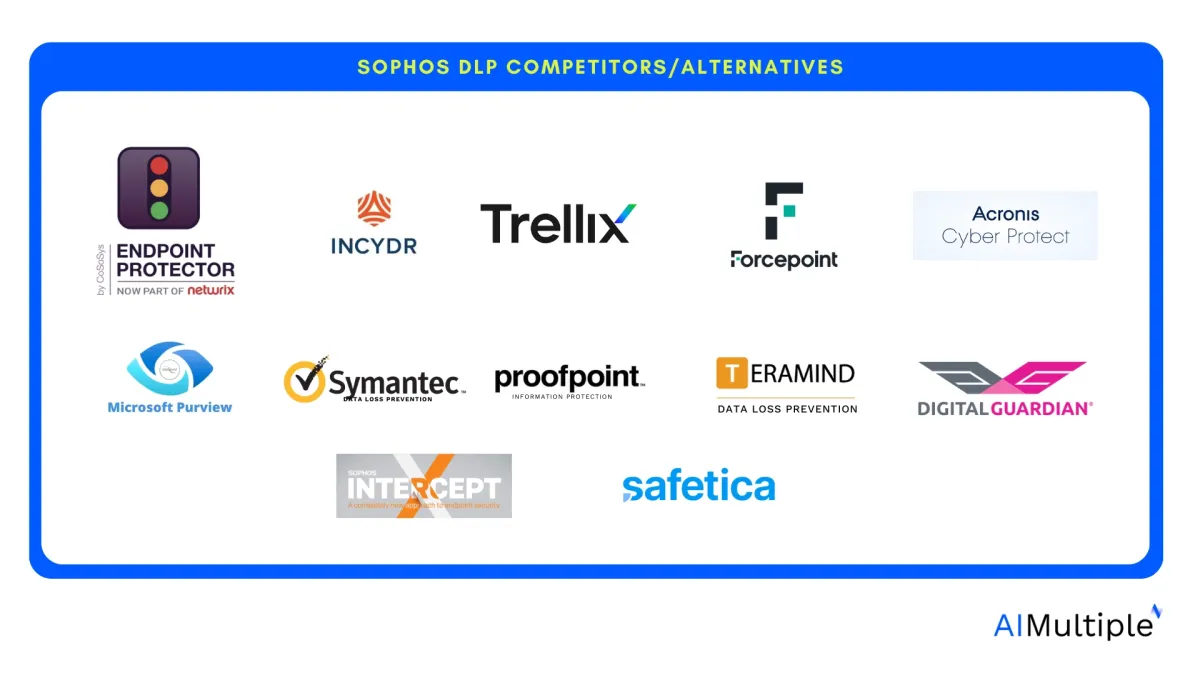Sophos is a popular player in the DLP software and cybersecurity markets. However, our analysis identified some shortcomings of its products. Based on our DLP benchmark of the top 6 DLP products, we identified the top Sophos competitors to assist businesses in finding the best DLP software.
We compare alternatives to:
Sophos Intercept X DLP alternatives
Here we compare the top Sophos DLP alternatives:
| Vendor | # of Reviews* | User Rating* | Free Trial (in days) | Supported OS | Deployment Options | VDI Support |
|---|---|---|---|---|---|---|
| Endpoint Protector by CoSoSys | 160 | 4.5 | ✅ | Windows, MacOS, Linux, Thin Client | On-prem, Public cloud, SaaS | ✅ |
| Trellix DLP (McAfee) | 1,792 | 4.2 | ✅ 60 | Windows, MacOS | On-prem, Public cloud | ❌ |
| Acronis Cyber Protect | 705 | 4.5 | ✅ 30 | Windows, MacOS, Linux | Public cloud, SaaS | ✅ |
| Sophos Intercept X | 480 | 4.5 | ✅ 30 | Windows, MacOS, Linux, Unix | On-prem, SaaS | ✅ |
| Safetica DLP | 263 | 4.7 | ❌ | Windows, MacOS, Linux | On-prem, Public cloud, SaaS | ❌ |
| Teramind DLP | 223 | 4.5 | ✅ 7 | Windows, MacOS | Public cloud, SaaS | ✅ |
| Symantec DLP by Broadcom | 156 | 4.3 | ❌ | Windows, MacOS | On-prem, Public cloud, SaaS | ✅ |
| Forcepoint DLP | 76 | 4.3 | ❌ | Windows, MacOS, Linux | On-prem, Public cloud, SaaS | ❌ |
| Digital Guardian Endpoint DLP | 63 | 3.7 | ❌ | Windows, MacOS | Public cloud, SaaS | ❌ |
| Microsoft Purview DLP | 36 | 4.4 | ✅ 90 | Windows, MacOS | Public cloud, SaaS | ❌ |
| Proofpoint Information Protection | 28 | 4.5 | ❌ | Windows, MacOS | Public cloud, SaaS | ❌ |
* Source: Leading B2B review platforms.
** The lowest rate for the most basic package in USD for 1 user/computer, billed annually.
Thin client: A lightweight software layer specifically designed to manage a network-based computing environment.
VDI: Virtual desktop infrastructure.
Requirements for inclusion in the table:
- Relevance of their offerings
- 100+ employees
Sorting: Vendors with links to their websites are sponsors of AIMultiple and are listed at the top. The remaining products are ranked based on their total number of reviews.
Sophos complete security platform alternatives
| Vendor | Offerings | # of Employees |
|---|---|---|
| Sophos | – Endpoint Security – Network Security – Cloud Security | 1K-5K |
| Cisco Secure Endpoint | – Endpoint Protection – Extended Detection & Response – Mobile Device Management | 10K+ |
| Palo Alto Networks | – Endpoint Security – Cloud-Native Application Protection – Network Security | 10K+ |
| Trend Micro | – Endpoint Security – Network Security – Email security | 5K-10K |
| SentinelOne | – Endpoint Protection – Cloud Security – Identity Protection | 1K-5K |
| WithSecure | – Endpoint Protection – Managed Detection & Response – Cloud Protection | 1K-5K |
| WatchGuard | – Endpoint Security – Network Security | 1K-5K |
| Bitdefender | – Network Security – Cloud Security – Threat Intelligence | 1K-5K |
| Cybereason | – Endpoint Security – Threat Intelligence | 1K-5K |
| Heimdal Security | – Endpoint Security – Patch & Asset Management – Privilege Access Management | 51-200 |
| Crowdstrike Falcon | – Endpoint Detection & Response – Threat Hunting – Behavioral Analysis | 11-50 |
Sorting: The vendors above are ranked based on the number of employees, with Sophos at the top.
Sophos review and shortcomings
Sophos Ltd. is a British security software and hardware company headquartered in Abingdon, England. Founded in 1985 by Jan Hruska and Peter Lammer, Sophos operates in the global cybersecurity market. The company provides a comprehensive range of products, including data loss prevention (DLP) solutions with its Intercept X product.
Shortcomings
We tested Sophos DLP and analyzed user reviews from leading review platforms to identify the following shortcomings.
1. Weak customer support
- Multiple user reviews suggest that Sophos customer support needs improvement. Users require faster and more sophisticated assistance.
- The stability of Sophos’s engine should be enhanced, as frequent updates and subsequent endpoint reboots disrupt live operations.
2. Expensive
- While users found the system easy to install, they were unhappy with the product prices.
3. Software issues
- The product may not function as promised in some environments, disrupting essential applications like Outlook, Excel, Word, PowerPoint, SharePoint, and Adobe Reader.
- Users experienced a high rate of false positives that overloaded their logs.
- The IMS Console is difficult to use. It offers extensive data but lacks actionable insights, and it does not provide metrics, inquiry, or reporting features.
4. Ineffective data classification
- Automated data classification was not effective in our tests, misclassifying risky emails with confidential attachments as low-risk.
- Although customization options are available, the data classification features did not meet expectations.
5. Limited default policies
- Default/base policies for peripherals and email did not stop confidential file transfers. However, custom policies blocked them effectively.
- The application control feature did restrict file transfers to platforms like Google Drive, but overall, the default policies were insufficient.
4. Missing user activity features
- Sophos does not offer user screen recording capabilities, which can be used to record when a user performs a task that violates the DLP policies. This feature is provided in some solutions like Teramind.
5. Administrative shortcomings
- The agent file sometimes disrupts productivity since it is difficult to disable or uninstall. It quarantined our computer.
- The platform does provide effective tamper protection and audit trail logging. However, the tamper protection feature sometimes disrupts productivity since it is difficult to disable or uninstall. It quarantined our computer.
Detailed analysis of DLP alternatives

1. Endpoint Protector by CoSoSys
Based in North Carolina, Endpoint Protector by CoSoSys (now part of Netwrix) is the best alternative to Sophos based on our benchmarking tests. Its device control feature is the most comprehensive in our analysis and user reviews.
Best for: Organizations prioritizing device control and granular endpoint security.
Key features
- Comprehensive device control: Endpoint Protector offers control over 30+ types of removable devices and peripherals, including USBs, Bluetooth devices, smartphones, and more. This is the highest among all competitors. Its data classification was also accurate and performed well during our tests.
- Panic functionality: Instantly lock/wipe devices during security incidents.
- Accurate data classification: AI-driven detection of PII, financial data, and IP protects sensitive data from unauthorized access and theft.
Strengths
- Smooth implementation: CoSoSys’s EPP offers a comprehensive DLP solution and good customer support. Reviews also highlight that its implementation team is helpful but can be improved.
- Thin client support: Ideal for virtualized environments (e.g., Citrix, VMware).
Weaknesses
- Limited cloud-native features: Less useful for cloud apps compared to competitors.
2. Symantec DLP by Broadcom
Another viable alternative to Sophos is Symantec, which is now part of Broadcom and is headquartered in California. It offers a DLP (Data Loss Prevention) solution to safeguard confidential data from cyber-attacks across various channels and environments. Symantec also claims to deliver various cybersecurity products, encompassing endpoint security, web and email security, and identity protection solutions.
Best for: Enterprises requiring robust data protection with regulatory compliance.
Key Features:
- Automated Data Classification: Streamlines data management by automatically categorizing data, enhancing regulatory compliance, and overall efficiency.
- Advanced Security Measures: Effectively protects the enterprise’s sensitive information (e.g., social security numbers).
- User Education: Provides tools and guidance to help educate users on DLP best practices.
- Network Prevent Controls: Incorporates features designed to stop data leakage, despite some functional restrictions.
Strengths:
- Effective Data Protection: Delivers strong security capabilities, ensuring sensitive data is well-protected throughout the organization.
- Regulatory Compliance: Facilitates adherence to compliance standards through efficient data classification and management.
Weaknesses:
- Configuration Hurdles: The setup and configuration process can be complex and demanding. It also has competitive cloud storage costs.
- Feature Restrictions: Certain functionalities—particularly within the Network Prevent features—face limitations.
For more on Symantec and its alternatives.
3. Forcepoint DLP
Forcepoint DLP, founded in 1994, is headquartered in Austin, Texas. The company is a suitable alternative to Sophos because it claims to specialize in data loss prevention solutions aimed at helping organizations secure their sensitive data and prevent unauthorized access or leaks. Forcepoint’s DLP offerings include tools for monitoring and controlling data transfers across networks, endpoints, and cloud environments.
Best for: Enterprises focused on network security and regulatory compliance.
Key features
- Activity monitoring policies: Adjusts controls based on user behavior and context. Enables security administrators to identify real-time sensitive data exposure within applications and trace user behaviors leading up to incidents.
- Cross-platform visibility: Monitors data across email, cloud, and endpoints.
- Compliance templates: Pre-built frameworks for GDPR, HIPAA, and PCI DSS.
Strengths
- User-friendly UI: Simplified policy management for non-technical teams.
Weaknesses
- No Linux support: Limits compatibility for tech-heavy industries.
- Weak OCR: Struggles with image-based document analysis.
For more on Forcepoint DLP alternatives.
FAQs for Sophos competitors
Why use DLP software?
Importance of Defending Against Cyber Threats
Companies should prioritize defending against cyber threats, which are becoming increasingly common and sophisticated. Data Loss Prevention or DLP software acts as a powerful solution, tracking data movements, spotting unauthorized access, and actively preventing breaches to safeguard confidential or sensitive organizational data.
DLP Software as a Key Solution for Data Security
Implementing DLP software is essential for companies aiming to enhance their endpoint security and safeguard sensitive data from cyber threats. This popular endpoint security solution offers comprehensive security features such as malware detection, advanced threat intelligence, and intrusion prevention, which are pivotal in defending against cyber attacks and phishing attacks.
Comprehensive Features of DLP Software for Endpoint Security
By deploying DLP software, companies ensure complete protection of their network, utilizing features like next-generation firewalls, URL filtering, and email security across multiple devices, including mobile and endpoint devices.
Centralized Management and Operational Efficiency
Its centralized management enables real-time visibility and response capabilities, boosting operational efficiency and strengthening the overall security posture. Moreover, the software’s user-friendly interface and cloud-based management system facilitate easy access, management, and patch management, essential for maintaining secure and up-to-date operating systems.
Suitability of DLP Software for Businesses of All Sizes
With its comprehensive protection features and competitive pricing, DLP software is the right solution for small businesses and large enterprises looking to efficiently protect their intellectual property and secure their networks against emerging threats.
Why are we looking at Sophos alternatives?
Investing in a DLP solution can involve significant costs, making it crucial to choose the right tool carefully. After analyzing user reviews, we have identified several limitations in Sophos that may prompt current or potential customers to consider its alternatives.


Comments
Your email address will not be published. All fields are required.